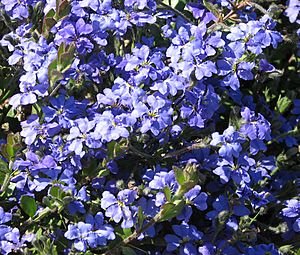Common dampiera facts for kids
Quick facts for kids Common dampiera |
|
|---|---|
 |
|
| Scientific classification | |
| Genus: |
Dampiera
|
| Species: |
linearis
|
| Synonyms | |
|
Dampiera cuneata R.Br., 1810 |
|
The Common Dampiera (Dampiera linearis) is a beautiful plant often called wedge-leaved dampiera. It's a type of herb that stands upright and lives for many years. This plant belongs to the Goodeniaceae family. You can find it only in the southwest part of Western Australia. It usually grows between 15 and 60 centimeters (about 6 inches to 2 feet) tall. Its lovely blue or purple flowers bloom from July to December. People also like to grow it in gardens, especially in pots or hanging baskets.
Contents
What's in a Name? (Taxonomy)
Have you ever wondered how plants get their names? The famous botanist Robert Brown first described the Common Dampiera in 1810. He wrote about it in his book called Prodromus Florae Novae Hollandiae et Insulae Van Diemen.
The plant's scientific name, linearis, comes from a Latin word meaning "linear" or "straight." This might refer to the shape of its leaves or how it grows. Robert Brown also described another plant, Dampiera cuneata, at the same time. Later, scientists realized that D. cuneata was actually the same plant as D. linearis. So, D. cuneata became a synonym, meaning it's another name for the same species.
Later, in 1845, a Dutch botanist named Willem Hendrik de Vriese described two more plants. He called them Dampiera azurea and Dampiera eriophora. He found them near the Swan River and Perth. But guess what? Scientists later found out these were also the same as Dampiera linearis! It just goes to show how much scientists learn over time.
What Does It Look Like? (Description)
The Common Dampiera is an upright plant that can grow from 15 to 60 centimeters (about 6 inches to 2 feet) tall. It has a special way of growing where new shoots can pop up from its roots, spreading out.
When the plant is young, its new growth is a bit hairy. But as it gets older, these parts become smooth. Its leaves are shaped like an oval or a spoon. They are usually between 1 and 4 centimeters long and 1 to 10 millimeters wide. Some leaves are smooth all around, while others have small lobes or bumps.
The most exciting part is its flowers! They bloom from July to December in their natural home. Each flower is about 1.5 to 2 centimeters wide. They are usually a pretty light blue or purple color, often with a yellow or white center. If you look closely, the outside or underside of the flowers is covered with tiny, fine hairs. These flowers grow in small groups of 1 to 3 on a stem that is also covered in hair.
Where Does It Live? (Distribution and Habitat)
The Common Dampiera is found only in the southwest part of Western Australia. You can see it from Geraldton in the north all the way down to Esperance in the southeast.
This plant likes to grow in certain types of soil. It prefers sandy or clay soils that are found over a type of rock called laterite. You can often spot it growing on ridges (like small hills) or in flat, open areas.
How Does It Survive? (Ecology)
The Common Dampiera is a tough plant! If there's a bushfire, it can survive. After the fire, it quickly grows new shoots and leaves. This ability to bounce back helps it thrive in areas where bushfires are common.
Scientists have also studied this plant on the Swan Coastal Plain. They found that it might be resistant to a plant disease called Phytophthora cinnamomi. This disease can be very harmful to many plants, so being resistant is a big advantage for the Common Dampiera.
Can You Grow It? (Cultivation)
Yes, you can! Many people grow different types of Common Dampiera because of their colorful flowers. Some varieties even have attractive grey leaves.
If you want to grow this plant, it likes a spot where the water drains away easily. It also prefers full sun or a little bit of shade. It can handle some dry periods and even a bit of frost. However, it really doesn't like having its roots sitting in soggy, waterlogged soil. It looks especially nice when grown in hanging baskets!
It's quite easy to start new Common Dampiera plants from cuttings. Experts at Kings Park found that using semi-hardened parts of the plant works best. On average, it takes about 48 days for the cuttings to start growing roots.

